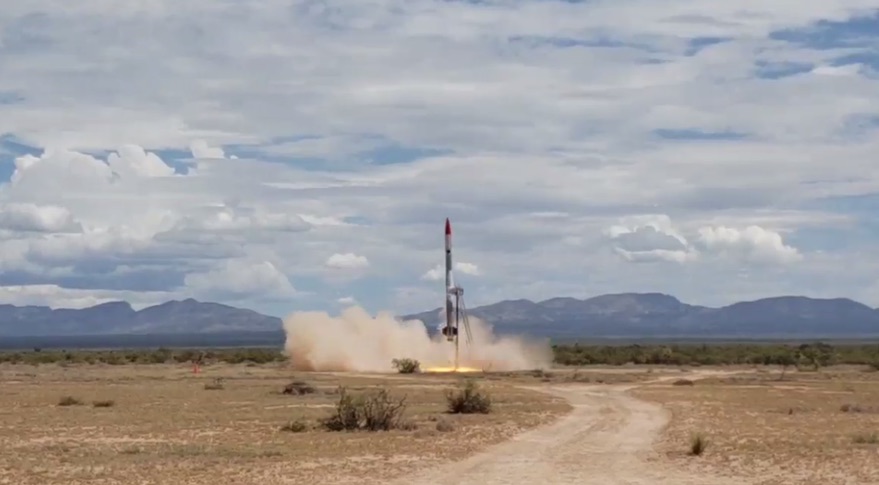Government Shutdown Delays Commercial Rocket Launch

WASHINGTON — The ongoing partial government shutdown has led one company to delay an upcoming launch and could affect other commercial launches in the near future, including a key commercial crew mission.
Exos Aerospace had planned to launch its SARGE suborbital rocket Jan. 5 from Spaceport America in New Mexico. That launch has been delayed to Feb. 9, John Quinn, chief operating officer of the company, said Jan. 2.
Quinn said a major reason for the delay was the inability of the company to get its existing launch license from the Federal Aviation Administration's Office of Commercial Space Transportation modified. The company was seeking to modify the license to change wind-related safety calculations in order to reduce the chance of a launch scrub. [Space Events to Watch in 2019!]
"FAA was not supporting license modifications during the shutdown, so we delayed for the potential to decrease the probability of a scrub based on the wind placard restriction in our license," he said.
The FAA, part of the Department of Transportation, is one of the government agencies affected by the partial government shutdown that started Dec. 22 when a continuing resolution funding those agencies expired. The FAA announced Dec. 22 that only "exempt" activities would continue during the shutdown. That includes "commercial space launch oversight," according to the department's shutdown plan, but no other activities related to commercial space transportation.
Quinn said that, had Exos decided to go ahead with the launch, the FAA would have assigned personnel to support it. However, the company decided to delay the launch to buy more time to get its license modified. A factor in that, he said, was limited supplies and high costs of helium, used to pressurize the vehicle's propulsion system; delaying the launch reduces the chance that helium would be wasted on a wind-related launch scrub.
The launch will be the second for SARGE, a reusable sounding rocket developed by Exos for flying payloads to the edge of space. The rocket, on its first launch Aug. 25, suffered a problem with its GPS receiver that triggered an early shutdown of its main engine. The rocket reached a peak altitude of 28 kilometers — far less than the planned 80 kilometers — before gliding back to a landing near the launch site. Had the GPS receiver not malfunctioned, the company said the rocket could have flown to nearly 90 kilometers.
Breaking space news, the latest updates on rocket launches, skywatching events and more!
Other commercial launches are proceeding as planned despite the shutdown. SpaceX is preparing its first Falcon 9 launch of the year Jan. 8, launching the final batch of Iridium Next satellites from Vandenberg Air Force Base in California. That launch remains on track despite the shutdown as the company has an existing license for such launches.
The next launch of Blue Origin's New Shepard suborbital vehicle, previously planned for mid-December, was pushed back to "early 2019" after a series of technical issues and poor weather at its West Texas launch site. The company has an FAA license for such launches, but it's uncertain if the shutdown will have any effect on payloads the launch would carry through NASA's Flight Opportunities program, as NASA is also affected by the shutdown. A company spokesperson did not respond to a request for comment about its launch plans Jan. 2.
The impact of the shutdown on NASA may delay another SpaceX launch. Prior to the shutdown, SpaceX was scheduled to launch its first commercial crew demonstration mission, DM-1, Jan. 17. That mission will send a Crew Dragon to the International Space Station, but with no astronauts on board.
SpaceX rolled out the Falcon 9 rocket, with the Crew Dragon spacecraft on top, to Launch Complex 39A early Jan. 3 for a series of tests on the pad. However, with the shutdown ongoing, NASA personnel needed to support the flight, such as for reviews prior to launch, have been furloughed, according to industry sources. That would likely delay the launch, even if the spacecraft and launch vehicle are ready.
SpaceX may also need a new or modified FAA launch license for the mission. An existing launch license covers launches of cargo version of the Dragon spacecraft from Launch Complex 39A, but it's not clear if that license can also be used for a Crew Dragon spacecraft. A SpaceX spokesperson said Jan. 3 said the company was looking into any shutdown-related issues that could affect upcoming launches.
This story was provided by SpaceNews, dedicated to covering all aspects of the space industry.

Jeff Foust is a Senior Staff Writer at SpaceNews, a space industry news magazine and website, where he writes about space policy, commercial spaceflight and other aerospace industry topics. Jeff has a Ph.D. in planetary sciences from the Massachusetts Institute of Technology and earned a bachelor's degree in geophysics and planetary science from the California Institute of Technology. You can see Jeff's latest projects by following him on Twitter.

